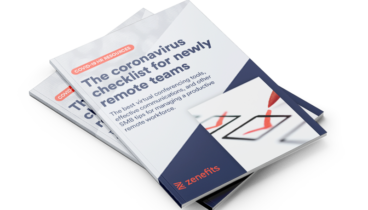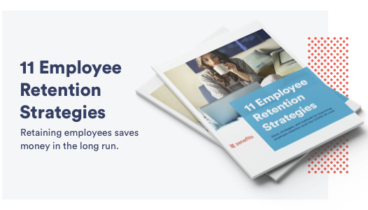2020 has brought its fair share of obstacles. Here’s how HR staff can be ready to tackle whatever comes their way and come out stronger.

Here's what you need to know:
-
Sick or COVID-19 positive employees must stay home and not return to work until they’ve recovered
-
Businesses must create a safe environment for employees and customers
-
HR needs to stay on top of every local, state, and federal requirement
-
Easing workers back in on a part-time basis, and/or offering remote work or extended leave are staffing options
-
Guidance to staff members on how to maintain distance, keep surfaces sanitized, and protect themselves and their colleagues should be part of the daily routine
-
Companies who offer remote/flex work will need to figure out how to best manage staff and schedules out of the office
-
Keeping staff informed on what’s required of you and what you’re doing to assure their safety and customers’ safety will be key
-
When your HR team, business, and employees have access to the most information available, you should be able to address any fears and concerns
In a normal work year, HR professionals and small and medium-sized business owners who manage the HR function are pressed with challenges many larger organizations don’t typically face. In today’s uncertain climate, those challenges are amplified. Facing the incredible pressure presented by the COVID-19 pandemic, business owners are adapting nearly everything about their organizations. For the HR function, the challenges may be even greater.
A recent survey by Josh Bersin and MIT Sloan Management Review polled HR professionals on what they’re doing to respond to the pandemic. Not surprisingly, top of the list was managing employee health and wellbeing. As you anticipate needing to keep employees safe and business moving forward, be prepared for whatever the virus, the government, and the economic conditions send your way. Some areas to get ready for — for HR and owners — are likely challenges everyone is facing in 2020.
1. Focusing on wellbeing
Employee health has always been a concern for business, but it’s magnified by the pandemic. As we struggle to keep the workplace safe for employees and customers, a new focus on health is a requirement. Employees who routinely came to work feeling under the weather must now stay home and not return to work until they’ve recovered, and possibly might need to be cleared to do so.
For HR professionals, sick time — once a payroll check-the-box issue — has come to the forefront. They’ll need to make sure everyone is well, getting the medical attention they need, and confident they can return to the workplace safely for themselves and others.
For companies that hadn’t offered healthcare benefits in the past, the pandemic may have shifted priorities to provide coverage for staffers. Many are now finding the cost/benefit ratio has shifted toward offering at least basic health coverage.
For companies that hadn’t offered healthcare benefits in the past, the pandemic may have shifted priorities to provide coverage for staffers.
2. The COVID-19 ripple effect
Returning to post-pandemic norms will be a challenge for businesses. For some, shutdowns shuttered your organization temporarily. For others, economic slowdowns have shifted hours, salaries, and production. Essential businesses have their own pressures — trying to maintain levels with illness and fear complicating the mix.
COVID-19 has impacted almost all businesses. For HR professionals, layoffs, slowdowns, juggling schedules, and even making payroll have been difficult. Many have navigated the worst (hopefully) of the pandemic, and are gearing up to return to normalcy. This will include a host of new challenges creating a safe environment for employees and customers.
3. Compliance
Regulatory compliance can be stressful in a normal business climate; today, it can seem like trying to hit a continuously moving target. Shutdowns, physical spacing, return-to-work guidelines, and other state and local mandates evolve as the spread of COVID-19 waxes and wanes by cities, states, and zip codes.
In today’s environment, businesses and HR professionals need to be ready to adapt on a day’s notice.
For most businesses, past regulations and requirements evolved slowly and with time to adjust. In today’s environment, businesses and HR professionals need to be ready to adapt on a day’s notice. Whether guidelines are coming from local authorities, the federal government, or the CDC, HR needs to stay on top of every requirement necessary.
4. Staffing levels
Maintaining staffing levels before 2020 was a challenge: In today’s market it may be even greater. Although unemployment levels are at record highs due to the pandemic, many businesses are having difficulty hiring.
The wage competition between regular wages, and generous unemployment benefits from states and the federal government, has added a new component to the hiring challenge. Some employees are earning more staying home than they would coming into work.
For organizations calling workers back to the rolls, there may be even more pressure knowing that your staffers will essentially take a pay cut if they return, but needing them to do so nonetheless. For many, easing workers back in on a part-time basis — to keep them qualified for the additional federal funding — has been the only solution until the benefit runs out. Remote work or extended leave may be the only option for staffers who have higher risk.
5. Adopting safety protocols
As new mandates come down, businesses are adapting to the safety measures required of them. There are some who are adopting measures they feel may be necessary or helpful, even when not mandated. Organizations are placing distance-markers on the ground, temperature checking employees and guests, and more.
Cleaning protocols and services are being stepped up; companies are shutting down break rooms or eliminating seating. Guidance to staff members on how to maintain distance, keep surfaces sanitized, and protect themselves and their colleagues is now part of the daily routine.
Continuously looking for guidance on what more they can do, HR professionals and SMB owners who fill that role are often pulling double-duty as the safety manager of their organization as well as the HR function.
6. Juggling and managing remote/flex work
If you’ve been able to move to fully or partially remote work for staffers, the challenge may now be managing staff and their schedules out of the office. For some, the transition has been smooth. For others, plunged into a remote work model, HR has been playing catch up trying to find and adopt software to meet the need to work and communicate.
In addition, managing a remote staff has its own challenges. As the ripple effect of the virus has shut down schools and caregiver facilities, parents are often juggling working from home and attending to family. The ability to manage productivity while working with staff members who are in a difficult position has put extra pressure on business and HR.
7. Constant communication
Keeping staff informed on what’s required of you and what you’re doing to assure their safety and the safety of your customers will be key.Communication will be key for HR professionals during these trying times. Keeping staff informed on what’s required of you and what you’re doing to assure their safety and the safety of your customers will be key. When staff members understand the responsibility you’re taking and the responsibilities they hold to keep safety and sanitization protocols working, everyone will be better off. It’s more than emails and texts — signage that reminds and directs will also be necessary.
Beyond communicating practical needs, keep messaging current and upbeat. The pandemic has put many workers — on premises and remote — in a challenging position mentally and physically. The more you can reassure them you’re doing your best to help, the easier it will be for them.
Remember communication is a two-way street. You’ll likely be fielding unending calls for help, information, and assistance. While it may seem overwhelming, be available as much as possible to allay fears and provide assistance and support.
8. Uncertainty
One of the most insidious aspects of the pandemic is the uncertainty because of it. Will business be able to maintain productivity and stay afloat with economic downturns? If employees return to work — giving up their unemployment benefits — will their jobs be assured? If there’s an uptick of cases in your community, what will occur? So much uncertainty can lead to fear and distrust. HR’s role will be to try to quell the panic and keep employees informed and assured, as much as they possibly can.
There are no guarantees — for business or employees — but adhering to the best advice available can minimize risk. Notifying staff members of your business plan to assure they’ll have jobs to return to and keep when the pandemic finally ends will be key to reestablishing trust in these uncertain times. When your HR team, business, and employees have access to the most information available, you should be able to address any fears and concerns that come your way.
An internet search of HR challenges for 2020 that were posted in 2019 seems almost quaint today. But a recent survey found 88% of leaders believe the outbreak has allowed them to “effectively demonstrate the importance of HR strategies toward mitigating people risk.” Businesses are facing unprecedented challenges and pressures: those who prepare may fare better today and be better off in the future.





